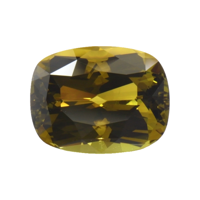Treatments and Enhancements of Chrysoberyl

Chrysoberyl gemstones, renowned for their exceptional clarity and unique color-changing properties, are highly prized in the gemstone market. While enhancements in chrysoberyl are less common than in some other gemstones, understanding the treatments and enhancements of chrysoberyl is crucial for both buyers and sellers.
This knowledge ensures informed and ethical gemstone trading, maintaining the integrity and value of these beautiful stones. By learning about potential treatments such as heat treatment or irradiation, enthusiasts can appreciate the true worth and longevity of chrysoberyl gemstones.
Common Treatments for Chrysoberyl
- Heat Treatment:
- Process: Chrysoberyl can be subjected to heat treatment, where it is heated at high temperatures under controlled conditions.
- Purpose: The primary goal is to enhance the clarity and color of the stone. For alexandrite, heat treatment may be used to intensify the color change effect.
- Frequency: This is a relatively uncommon treatment for chrysoberyl compared to other gemstones like sapphire or ruby.
- Radiation Treatment:
- Process: Some chrysoberyl, especially those intended to mimic alexandrite’s color change, may undergo radiation treatment.
- Purpose: To alter or enhance the color-change effect.
- Note: This treatment is rare and not a standard practice for chrysoberyl.
- Oiling or Filling:
- Process: Unlike stones like emerald, chrysoberyl rarely undergoes any form of oiling or filling treatments, as it typically does not have the types of inclusions or fractures that would require such enhancements.
Detection and Disclosure of Enhancements
In the gemstone industry, the integrity and value of chrysoberyl largely depend on its natural characteristics and any enhancements it may have undergone. This guide, tailored for a gemstone website, aims to educate readers about the importance of detecting and disclosing enhancements in chrysoberyl, highlighting the methods used for detection and the ethical implications of transparent disclosure.
Understanding Enhancements in Chrysoberyl
- Nature of Enhancements: Chrysoberyl, including its varieties like alexandrite and cat’s eye chrysoberyl, is known for its natural beauty and rarity. Enhancements, if any, are typically less common compared to other gemstones but can include treatments like heat treatment or radiation.
- Purpose of Enhancements: Enhancements in chrysoberyl are primarily aimed at improving color or clarity. For instance, heat treatment may be used to enhance the color change in alexandrite.
Detecting Enhancements in Chrysoberyl
Gemological Laboratories: Professional labs equipped with advanced technologies play a crucial role in identifying enhancements in chrysoberyl. They use various methods to analyze the stone’s structure and composition.
Equipment and Techniques:
- Microscopic Examination: A detailed microscopic analysis can reveal signs of heat treatment or other alterations.
- Spectroscopy: Spectroscopic methods help detect subtle changes in the stone’s crystal structure that could indicate enhancement.
Expert Evaluation: Experienced gemologists can often identify signs of enhancement through visual inspection, although some sophisticated treatments may require laboratory analysis for confirmation.
Ethical Disclosure of Chrysoberyl Enhancements
Importance of Transparency: Full disclosure of any treatments in chrysoberyl is vital for ethical trading practices. This transparency ensures that buyers are aware of the true nature and value of their purchase.
Legal and Ethical Obligations: In many countries, the disclosure of gemstone treatments is not only an ethical responsibility but also a legal requirement. Non-disclosure can lead to legal issues and damage to reputation.
Impact on Value and Care: Understanding whether a chrysoberyl has been enhanced is essential for determining its value and proper care. Some treatments can affect the gemstone’s durability and require specific maintenance.
Certification and Documentation: Certificates from reputable gemological institutions are crucial in verifying the untreated status of chrysoberyl or detailing any enhancements it has undergone.
Educating Consumers on Chrysoberyl Enhancements
- Building Knowledge and Trust: Providing detailed information about the potential enhancements in chrysoberyl and the importance of detection helps build consumer trust and enables informed purchasing decisions.
- Interpreting Certifications: Educating consumers on how to read and understand lab certificates, especially regarding enhancement disclosures, empowers them in the gemstone market.
K2208| play | right| “4.85 Ct. Ceylon (Sri Lanka) No Enhancement Brown Chrysoberyl”Enhancements in chrysoberyl gemstones are less common than in others, but detecting and disclosing any treatments are essential to maintain their integrity and value. Educating buyers about these treatments, such as heat treatment or irradiation, is crucial for informed and ethical trading. Ethical disclosure ensures the gemstone’s integrity and buyer satisfaction, and understanding these aspects is key to appreciating the true value and longevity of chrysoberyl gemstones.
Discover the allure of one of the most enchanting gemstones! Start exploring with our Introduction to Chrysoberyl here!
